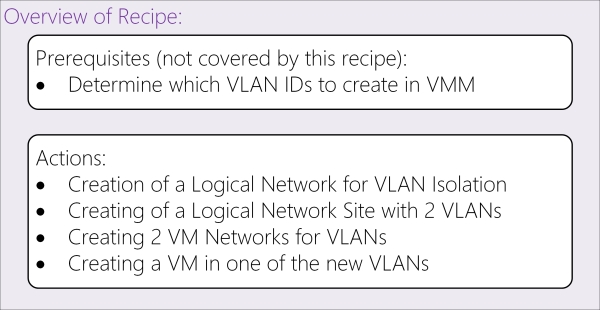Understanding VLANs in Hyper-V and VMM, including the PowerShell cmdlets
VLANs in Hyper-V allow for the isolation of traffic. It is possible to set a network adapter to trunk VLANs into a VM; an example use case for this could be a network load balancer that is responsible for multiple VLANs.
Getting ready
In this recipe you will be creating additional VLANs in VMM and will require a new VLAN ID and subnet.
How to do it…
The following diagram shows you the high-level steps involved in this recipe:

This table shows you the VLANs and the settings that will be applied:
|
Setting Name |
Value | |
|---|---|---|
|
Logical Network Name |
VLAN Testing | |
|
Logical Network Site Name |
VLAN Testing_0 | |
|
VLAN ID |
150 |
151 |
|
IP subnet |
192.168.150.0/24 |
192.168.151.0/24 |
|
IP pool name |
IPP-VLAN_Testing_0-150 |
IPP-VLAN_Testing_0-151 |
|
IP pool start address |
192.168.150.2 |
192.168.151.2 |
|
IP pool end address |
192.168.150.254 |
192.168.151.254 |
|
VM Network Name |
VMN-VLAN_Testing_0-150 |
VMN-VLAN_Testing_0-151 |
Now perform the following...






















































